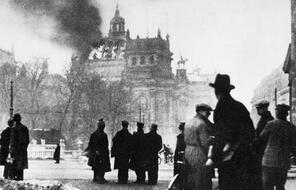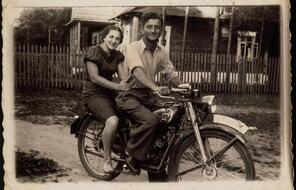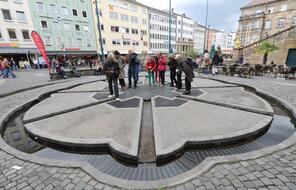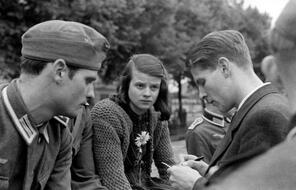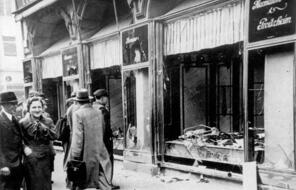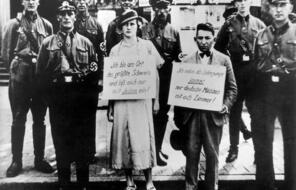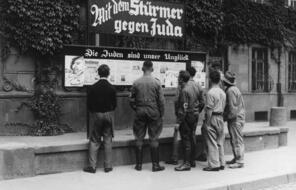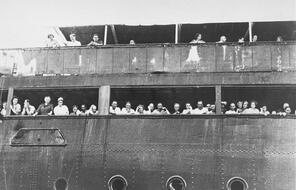“Marking the Days of Awe in Sidi Aziz (1942)”
At a Glance
Language
English — USSubject
- History
- Social Studies
- The Holocaust
In December 1940, the British military launched an attack on Italian forces in western Egypt and eastern Libya. Then, in the Spring of 1941, the Nazis joined the Italian forces to push the British back out of Libya, and the territory exchanged hands multiple times. In 1942, as the British were once again forced out of Libya, Italian Fascist leader, Benito Mussolini, passed an order for Jews in the region to be deported to labor camps. This document is an excerpt from the writing of Amishadai Guetta, a Libyan Jew who was interned in a camp called Sidi Aziz.
. . . About ten days before Rosh Hashana 1 , the first enlisted people were sent. . . . On rickety trucks, without inspection, without organization and in no order, everyone crowded and standing, hundreds of boys and heads of families were sent, mercilessly cut off from their relatives, and abandoned in a place within the Libyan desert sands—Sidi Aziz. They lived in tents, destitute, and most of them lay on the ground, snakes and scorpions ran [all] around them, and annoying mosquitoes disturbed their moments of sleep. Their food was only bread and murky water, sparingly, which was pumped mercifully from the Bedouin 2 wells, quelling their thirst somewhat. From early morning until dusk, the exiles were engaged in all kinds of grunt work, laying the Libya-Egypt railroad under the scorching sun and at the hands of cruel taskmasters. The awful days 3 had come: instead of the elegant and glorious synagogue, a small, meager, low-rise tent was erected. Instead of seven ornate Torah scrolls 4 decorated with flowers, only one Torah scroll was used. Instead of freshly ironed clothes, the worshipers wore dirty, torn clothing. Instead of the smell of perfume, the smell of sweat and grime (the severe water shortage prevented the worshipers from bathing and washing their clothes). Of course, prayers on the night of Rosh Hashanah and Yom Kippur 5 were held in the dark because of the prohibition against turning on lights during the war. Rosh Hashanah and Yom Kippur, the days of awe for which fathers and sons filled the synagogues en masse until no room remained, to pour out, whispering, in [the] glory of holiness and melancholy melodies, turned into days of sadness, grief and sorrow. The rumors of the Nazi extermination camps caused endless worry and anxiety both in the hearts of detainees and in hearts of their relatives, [all worried] about their own fates.
The sorrow of separation from their families was especially felt by the prisoners at the closing prayer that Yom Kippur. At this time, in which all Tripolitan 6 Jews used to bring their children, including the babies, to the synagogues for the “priestly blessing,” there was a shared and strong feeling. The question of “will I return and see my children?” nibbling at their hearts. And with tears on their faces and a broken, gloomy heart, they uttered the most sublime and special prayers of the year. There is no doubt that the tears of these depressed people rose to the heavens and the next day. . . . 7
- 1The Jewish New Year celebrating the new lunar calendar year and starting 10 days of repentance referred to as the Days of Awe.
- 2 Nomadic Arab tribes.
- 3The Awful Days are the 10 Days of Awe starting with the Jewish New Year that are dedicated to reflection, repentance, and renewal.
- 4A long scroll containing the Five Books of Moses handwritten in Hebrew.
- 5The Day of Atonement, a fast day (i.e. a day without food or drink) spent in prayer and reflection. It is the last of 10 Days of Awe that start with Rosh Hashanah.
- 6From Tripoli, Libya.
- 7Stein, Sarah Abrevaya, and Aomar Boum. “Guetta, A. Va’ad kehilot Luv be-Yisra’el, Yahadut Luv: Ma’amarim u-reshimot ‘al haye ha-Yehudim be-luv: yotse le-’or le-regel melot ‘eser shanim la-’aliyat Yehude luv. Tel Aviv: Va’ad kehilot Luv be-Yisra’el, 1960. Translated from Hebrew by Jessie Stoolman.” Essay in Wartime North Africa: A Documentary History, 1934–1950 (Stanford, CA: Stanford University Press, 2022), 202.
How to Cite This Reading
Facing History & Ourselves, "“Marking the Days of Awe in Sidi Aziz (1942)”," last updated June 30, 2023.
This reading contains text not authored by Facing History & Ourselves. See footnotes for source information.

